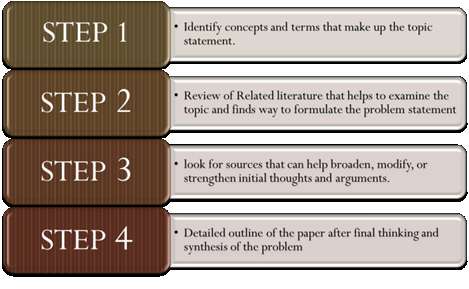PROBLEM STATEMENT IN RESEARCH
RESEARCH PROBLEM
It represents the core subject matter of scholarly communication, and the means by which we arrive at other topics of conversations and the discovery of new knowledge and understanding.
PROBLEM STATEMENT
A research problem is a definite or clear expression [statement] about an area of concern, a condition to be improved upon, a difficulty to be eliminated, or a troubling question that exists in scholarly literature, in theory, or within existing practice that points to a need for meaningful understanding and deliberate investigation.
STEPS IN PROBLEM STATEMENT

STEP 1: Identify concepts and terms that make up the topic statement
- Find out the aspects through which to view the research problem
- Determine the components of the initial variable or unit of analysis and this is broken into smaller parts, which can then be analyzed more precisely
- Formulate the method/ way in which information will be gathered
- Look for the place or geographical area where the research will be conducted
- Design the study around the relationships between specific variables that can help constrict the scope of analysis [e.g., cause/effect relationships
- Focus the topic in terms of a specific type or class of people, places, or phenomena.
STEP 2 REVIEW OF LITERATURE
- Reading through background information from materials listed in the course syllabus
- find a recent book, Journals and articles on the topic
- Conduct a preliminary review of the research literature using multidisciplinary databases or subject-specific databases
- Choose the advanced search option in the database and enter the main concept terms that are developed in the research
- consider search using their synonyms to retrieve additional relevant records
- Reviewing literature is done several times before finalizing how to write about the topic
Sources of Historical Content: This can help to demonstrate familiarity with developments in relevant topic, & provide a means of comparing historical versus contemporary issues and events, and identifying key people, places, and events that had an important role related to the research problem.
Sources of interdisciplinary insight: This is exploring the topic if it covers publications from a variety of different disciplines. Another way to formulate how to study the topic is to look at it from different disciplinary perspectives
STEP 3: Look for sources that can help broaden, modify, or strengthen the initial thoughts and arguments.
- Sources of criticism – This is one way that you can use a source is to describe the counter-argument, provide evidence from your own review of the literature as to why the prevailing argument is unsatisfactory, and to discuss how your approach is more appropriate based upon your interpretation of the evidence.
- Sources of New Ideas: It is certainly acceptable [and often encouraged] to extend, modify, and refine the research from our own position in light of the ideas proposed by others.
Step 4: Detailed outline of the paper after final thinking and synthesis of the problem
- An outline will show what the researcher intends to study. Use the outline to set goals for completing each section of your paper.
- It will help to stay organized and focused throughout the writing process and help ensure proper coherence [flow of ideas] in the final paper.
- A clear, detailed outline ensures that it always have something to help re-calibrate the writing i.e when it’s felt the topic is drifting into subject areas unrelated to the research problem. The outline is used to set boundaries around what will be investigated.
- The outline can be key to staying motivated. Making an outline is never as overwhelming as sitting down and beginning to write a twenty page paper without any sense of where it is going.
- An outline helps to organize multiple ideas about a topic. Most research problems can be analyzed from a variety of perspectives; an outline can help to sort out which modes of analysis are most appropriate to ensure the most robust findings are discovered.
- An outline not only helps to organize one’s thoughts, but it can also serve as a schedule when certain aspects of the writing should be accomplished. Review the assignment and highlight the due dates of specific tasks integrate these into the outline.
CRITERIA FOR GOOD PROLEM STATEMENT
- Clarity & Precision: A well-written statement must be easily understood by the reader
- Feasible: Demonstrate a researchable topic or issue [i.e., feasibility of conducting the study is based upon access to information that can be effectively acquired, gathered, interpreted, synthesized, and understood]
- Unbiased: Identification of what would be studied, while avoiding the use of biased words and terms
- Comprehensive: Identification of an overarching question or small set of questions accompanied by key factors or variables
- Concepts: Identification of key concepts and terms
- Delimitation: Articulation of the study's conceptual boundaries or parameters or limitations
- Generalization: Some generalizability in regards to applicability and bringing results into general public
- Significant: Conveyance of the study's importance, benefits, and justification [i.e., regardless of the type of research, it is important to demonstrate that the research is not trivial]
- Simple: Does not have unnecessary jargon or overly complex sentence constructions
- Brevity: Conveyance of more than the mere gathering of descriptive data providing only a snapshot of the issue or phenomenon under investigation.


